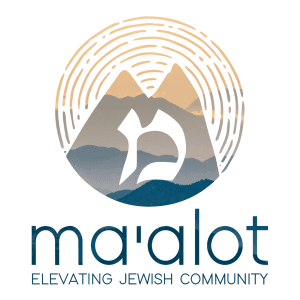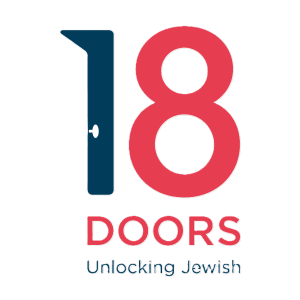Torah Commentary with Rabbi Laurence Rosenthal
Biblical Readings for Pesach 5782
The Torah of Passover
By Rabbi Laurence Rosenthal

The eight days of Passover are replete with Torah readings. Each day of this special holiday we have a Torah reading to celebrate, elevate, and help create a sense of holiness for each day of this festival of freedom. This is not completely unusual. Sukkot and Hanukah, both eight days long, have a Torah reading for each of the eight days. However, Passover is different. Whereas Sukkot and Hanukah's Torah readings each day are structured with a lot of repetition, reading from the same Torah portion for most of the days, the Passover readings for each of the day pull from all over the Torah. By looking at these eight disperse Passover Torah reading, one for each day, I hope to uncover an important message that our sages are trying to communicate to us through the placement of these each Torah readings, sending us a text message over many generations.
Saturday, April 16 – Passover Day 1
Torah Reading: Exodus 12:21-51 (Parshat Bo)
This Torah reading for the first day of Passover lays out the important steps that the Israelites needed to do in preparation of their freedom. This Parsha recalls the painting of blood upon the door post to separate the houses of the Israelites from those of the Egyptians. The text also talks about the haste taken to bake bread that has become the iconic unleavened bread that we eat throughout Passover. Our sidra for this first day ends with sharing the many people included among the Israelites who can partake in the pascal lamb offering.
Sunday, April 17 – Passover Day 2
Torah Reading: Leviticus 22:26-23:44 (Parshat Emor)
Chapter 23 of Leviticus lists the holidays that the Israelites are to observe. Starting with Shabbat, moving through the High Holidays and mentioning the three-pilgrimage festival, this chapter touches on the iconic elements or rituals of these holy days. Interestingly, although there plenty of pasukim (sentences) in Leviticus, chapter 23 to divide the chapter into separate aliyot for the public reading, this Torah reading begins in Chapter 26, prohibiting the slaughter of a calf on the same day as its mother. One can surmise that this prohibition recognizes the emotional distress that might be inflicted upon the animal by such trauma.
Monday, April 18 – Passover Day 3 (Chol HaMoed Day 1)
Torah Reading: Exodus 13:1-16 (Parshat Bo)
By the third day of Passover, the first day of Hol HaMoed (literally, the ordinary days of a festival) we are returning to the book of Exodus, to the instruction given to the Israelites before they left Egypt. This section commands the people that upon entering the land, they shall consecrate their first born to the service of God. It also institutes a spring holiday of unleavened bread during which we will teach our children about our freedom. Woven into this text is also an introduction to the signs of the covenant that we will put upon our arms and between our eyes, what would eventually become tefillin (phylacteries).
Tuesday, April 19 – Passover Day 4 (Chol HaMoed Day 2)
T-rah Reading: Exodus 22:24-23:19 (Parshat Mishpatim)
On the fourth day of Passover, we review a collection of laws which speak about ethical behavior spanning from a prohibition against usury to the commandment of returning to your enemy their lost property. We get a quick description of the Shemita year (7th year of rest for the land; we just happen to be in the Shemita right now) and finally the Torah reading ends with a reminder about observing the three pilgrimage festivals at their appointed time.
Wednesday, April 20th – Passover Day 5 (Chol HaMoed Day 3)
Torah Reading: Exodus 34:1-26 (Parshat Ki Tissa)
By the fifth day of Passover, we find ourselves reading a very special section of Torah (all sections of Torah are special, but you know what I mean): The 13 attributes of God. Exodus, chapter 34 begins with the instruction to Moses to carve a second set of tablets, like the first that were broken. Then, God calls out the 13 divine attributes which are recited as part of the service on Holidays and High Holidays. The instruction turns to fidelity, imploring the people not to follow the idolatry ways of the inhabitants of the land they will soon possess. There is a mention of the Feast of Unleavened bread, what we know as Passover, with a reminder that the first of every womb belongs to God and therefore must be redeemed. The reading concludes by mentioning the holidays of Shabbat and Shavuot.
Thursday, April 21 – Passover Day 6 (Chol HaMoed Day 4)
Torah Reading: Numbers 9:1-14 (Parshat Behaalotecha)
On the sixth day of Passover, our reading focuses on situations where a person might not be in a state of purity by the 15th of Nissan, case in point is when one encounters a dead body, and therefore can't participate in the Passover Seder at its requisite time. Therefore, this section of Torah establishes a little-known backup holiday called Pesach Sheni, the second Passover, where Jews and strangers within the Jewish community can observe the holiday of Passover later once purified.
Friday, April 22 – Passover Day 7
T-rah Reading: Exodus 13:17-15:26 (Parshat Beshallach)
The seventh day of Passover is the concluding day of the holiday (chag) and has an elevation of sanctity from the previous four days of Hol HaMoed. On this day, tradition recalls the actual exodus from Egypt. Whereas the first day of Passover reading is spent in preparation from the Israelite's departure, it is believed that on this seventh day, the people left. Therefore, our reading is known as the Song at the Sea, the joyful celebration that Miriam and Moses led for the people after the waters of the Reed Sea closed upon Pharoah and his army.
Saturday, April 23 – Passover Day 8
Torah Reading: Deuteronomy 14:22-16:17 (Parshat Reeh)
This final day of Passover, the eighth day is only observed in the diaspora (outside the land of Israel). For this reading, we travel deep into the book of Deuteronomy, our first exploration into this book during this holiday. Our reading begins with instructions concerning the tithes, a setting aside of a tenth of one's bounty for God and the service of the Temple in Jerusalem. Recognizing that depending on the size of one's farm or flock, a tenth could be a burdensome amount to haul up to the Temple in Jerusalem, an allowance to liquidate or assess the value of these assets and bring the amount to the Temple mount is proscribed. We are reminded to care for the Levite communities as they don't have an inheritance of the land, since their focus is on Temple service. The reading delves deeper into the observance of the Shemita year which was also mentioned in our text read on the fourth day of Passover. The reading concludes with another reminder to celebrate the three pilgrimage festivals, Passover, Shavuot, and Sukkot while also expanding the community of celebrants to include servants, slaves, and strangers.
—
That is a lot of Torah. The question I am interested in asking is, "What is the common thread in all of these? "What textual, spiritual Journey are we being led on through the readings of these various texts?" As always, there are many layers that we get the pleasure of uncovering each year. For me this year, this jaunt through scripture is highlighting the practice element of a "spiritual practice." We weren't brought out of Egypt to do whatever we want. We were brought out of Egypt, under servitude to Pharoah in order to serve God. To be of service takes refining. To be good at anything takes practice.
Spiritual practice is akin to being a musician. The only difference is that a musician can limit their playing to moments when they have their instrument in their hand. The instrument of spiritual practice is life, which is hard to put back in its case. Just like playing a musical instrument, the more one practices the better they sound, the more comfortable they feel with it in their hands, the more agile they might be when performing with others. A true musician also is good at listening to others playing around them, knowing when to step forward and solo or step back and keep the rhythm.
The Torah reading for Passover helps to frame out freedom as an opportunity to develop a spiritual practice. Freedom isn't free, it takes practice.
Chag Sameach!






























